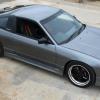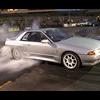more intercooler power
Announcements
-
Similar Content
-
Latest Posts
-
I started with the above in my head too, and I might be reading / thinking about what they want wrong, which is why I complicated it a bit further. Purpose I'm seeing is for the corner indicator to be on with headlights, and then if the indicator turns on it can still flash. The relay part above I can see working as required, except in the case of headlight is on, and indicator is on. The change over relay you've wired in would get signal from the indicator, and as it flashes would give power to the globe from the indicator, but as it flashes off, power comes from the headlight, which would cause the indicator to be constantly on when headlight is on, even while indicator change over is flashing. That is unless we don't care if it flashes or not if the headlight is on? I guess that's an OP clarification.
-
HI, Ive got an r34 gtt sedan A/T. The instrument cluster went out and I replaced it with another A/T everything visually looks the same and all the gauges work now with the exception of the speedometer and odometer. The speedo will stay pinned at zero until I'm going about 55kmh and then it'll say Im going about 5kmh. my odometer seems to be tracking at about a 1/10 of what it should. If I go 1km it'll say I've only gone 0.01. Appreciate any and all help. Ive tried searching through the forums reddit and a local fb group. The only info I think I've found is that some cars didnt come equipped with TCS (mind is) and the clusters may be different between those? I've also installed a brand new VSS and no joy obviously. TIA.
-
Certainly. It is probably broken under the wire style clamp. At least that one is easier to get at than the front one. Sounds like it isn't a major leak, I'd start with backing off the the water feed and return banjos into the turbos half a turn then tightening properly. Hardlines can still crack over time, either in the tube (particularly when turbos are changed if the banjo is siezed in the the tube) or at the brazed joins between the lines and the banjo fittings. A coolant system pressure test will reveal all. BTW you'd be able to get a sump without exchange, it will just cost more as they will have to source another stock one for the next customer. If you want to address the sump a much better option is something like this https://www.hioctanedirect.com/hi-octane-racing-sump-extension-nissan-rb26 that you weld in locally (and add the oil return fittings at the same time)
-
Pretty sure you are thinking of the throwout bearing there (which you should change when you change your clutch), when they are worn they will get quieter if you put your foot on the clutch. An input shaft bearing is turning/noisy at all times.
-








Recommended Posts
Create an account or sign in to comment
You need to be a member in order to leave a comment
Create an account
Sign up for a new account in our community. It's easy!
Register a new accountSign in
Already have an account? Sign in here.
Sign In Now